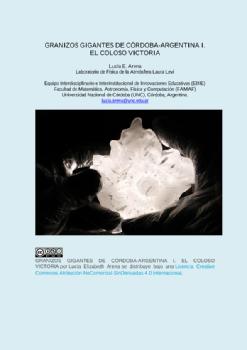| dc.contributor.author | Arena, Lucía Elizabeth | |
| dc.date.accessioned | 2020-08-21T23:03:42Z | |
| dc.date.available | 2020-08-21T23:03:42Z | |
| dc.date.issued | 2020 | |
| dc.identifier.uri | http://hdl.handle.net/11086/15963 | |
| dc.description.abstract | Desde su formación, el Grupo de Física de la Atmósfera (GFA) de la Facultad de Matemática, Astronomía, Física y Computación de la Universidad Nacional de Córdoba estudia granizos y los fenómenos físicos del hielo. Las piedras guardan información valiosa sobre las tormentas que los origina. Las granizadas permiten cotejar y validar los datos de los grandes instrumentos
meteorológicos (radar y satélite) y los granizos aportan información sobre la microfísica del ambiente en que se formaron. En el presente trabajo, se presentan algunos resultados de recolecciones de granizos gigantes (de 5 cm o más) de tormentas ocurridas en la provincia de Córdoba. Los granizos son recolectados por los vecinos y procesados por los investigadores en cámara de
baja temperatura en el laboratorio del GFA. Es notable que las tormentas de granizos gigantes sean registradas, fundamentalmente al este de las sierras de Córdoba y que estudios cristalográficos de granizos de tormentas de 1988 y
2018, no aporten diferencias significativas. Es importante destacar que se presentan los primeros cortes de un granizo de dimensiones extremas (mayores a 17 cm) correspondiente a la tormenta del 8 de Febrero de 2018 recolectado en
la Ciudad de Villa Carlos Paz. Este granizo supergigante ha sido denominado Coloso Victoria, y resulta, hasta el momento, el de mayores dimensiones recolectado y procesado en laboratorio, en Sudamérica. Sin embargo, dadas las características de la región es muy posible que se den otros eventos con granizos supergigantes. En la misma tormenta, el equipo de M. Kumjian ha
detectado a partir de información fílmica el granizo Gargantuan, de mayores dimensiones que el Coloso Victoria. | es |
| dc.description.abstract | Since its formation, the Group of Atmospheric Physics (GFA) of the Faculty of Mathematics, Astronomy, Physics and Computing of the National University of Córdoba has studied hail and the physical phenomena of ice. The hailstones store valuable information about the storms that originate them. Hailstorms allow data from large meteorological instruments (radar and satellite) to be collated and validated, and hailstones provide information on the microphysics of the environment in which they were formed. In the present work, some results of giant hail (5 cm or more) collected from storms that occurred in the province of Córdoba are presented. The hail is collected by the neighbors and processed by the researchers in a low-temperature chamber in the GFA laboratory. It is notable that giant hail storms are recorded, mainly east of the Córdoba mountains and that crystallographic studies of hail from storms in 1988 and 2018 do not provide significant differences. It is important to note that the first hail cuts of extreme dimensions (greater than 17 cm) corresponding to the storm of February 8, 2018 collected in the City of Villa Carlos Paz are presented. This supergiant hail has been called Colossus Victoria, and it is, to date, the largest collected and processed in the laboratory in South America. However, given the characteristics of the region, it is very possible that there will be other events with supergiant hail. In the same storm, M. Kumjian's team has detected Gargantuan hail, larger than Colossus Victoria, from film information. | en |
| dc.language.iso | spa | es |
| dc.rights | Attribution-NonCommercial-NoDerivatives 4.0 Internacional | * |
| dc.rights.uri | http://creativecommons.org/licenses/by-nc-nd/4.0/ | * |
| dc.subject | Granizos gigantes | es |
| dc.subject | Microfísica del ambiente | es |
| dc.subject | Tormentas de granizo | es |
| dc.subject | Recolección de granizos | es |
| dc.subject | Cristales | es |
| dc.subject | Burbujas | es |
| dc.subject | Tormentas severas | es |
| dc.subject | Giant hail | en |
| dc.subject | Crystals | en |
| dc.subject | Bubbles | en |
| dc.subject | Severe storms | en |
| dc.title | Granizos gigantes de Córdoba-Argentina I. El Coloso Victoria | es |
| dc.type | book | es |
| dcterms.coverage | Córdoba, Argentina | es |
| dc.description.fil | Fil: Arena, Lucía Elizabeth. Universidad Nacional de Córdoba. Facultad de Matemática, Astronomía, Física y Computación. Laboratorio de Física de la Atmósfera Laura Levi; Argentina. | es |
| dc.description.fil | Fil: Arena, Lucía Elizabeth. Equipo Interdisciplinario e Interinstitucional de Innovaciones Educativas; Argentina. | es |





